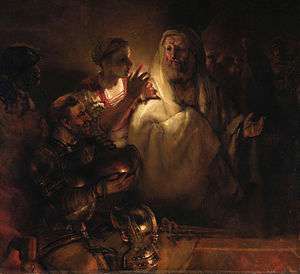Denial of Peter
The Denial of Peter (or Peter's Denial) refers to three acts of denial of Jesus by the Apostle Peter as described in all four Gospels of the New Testament.[2]
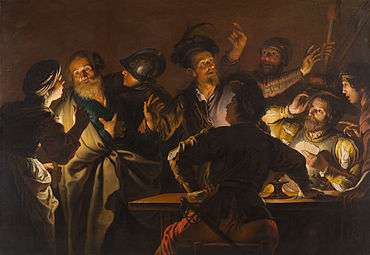
All four Canonical Gospels state that during Jesus' Last Supper with his disciples, he predicted that Peter would deny knowledge of him, stating that Peter would disown him before the rooster crowed the next morning. Following the arrest of Jesus, Peter denied knowing him three times, but after the third denial, heard the rooster crow and recalled the prediction as Jesus turned to look at him. Peter then began to cry bitterly.[3][4] This final incident is known as the Repentance of Peter.[5]
The turbulent emotions behind Peter's denial and later repentance have been the subject of major works of art for centuries. Examples include Caravaggio's Denial of Saint Peter, which is now at the Metropolitan Museum of Art. The incidents have also inspired segments in various films related to the life and death of Jesus Christ (for instance, when Francesco De Vito performed as Peter in The Passion of the Christ) as well as references in musical works, both religious and secular.
Biblical accounts


The prediction, made by Jesus during the Last Supper that Peter would deny and disown him, appears in the Gospel of Matthew 26:33-35, the Gospel of Mark 14:29-31, the Gospel of Luke 22:33-34 and the Gospel of John 13:36-38. The denial accounts in the Gospels differ from each other.
According to the Gospel of Matthew:
Peter replied, "Even if all fall away on account of you, I never will." "I tell you the truth," Jesus answered, "This very night, before the rooster crows, you will disown me three times." But Peter declared, "Even if I have to die with you, I will never disown you." And all the other disciples said the same.[6]
Later that night, Jesus was arrested. The first denial to a servant girl in Luke 22:54-57 is as follows:
Then they seized him and led him away, bringing him into the high priest's house. Peter followed at a distance and when they had kindled a fire in the middle of the courtyard and had sat down together, Peter sat down with them. A servant girl saw him seated there in the firelight. She looked closely at him and said, "This man was with him." But he denied it. "Woman, I don't know him," he said.[7]
The second denial to the same girl in Mark 14:69-70 is:
When the servant girl saw him there, she said again to those standing around, "This fellow is one of them." Again he denied it.[8]
The third denial to a number of people, is emphatic as he curses according to Matthew 26:73-75:
After a little while, those standing there went up to Peter and said, "Surely you are one of them, for your accent gives you away." Then he began to call down curses on himself and he swore to them, "I don't know the man!" Immediately a rooster crowed. Then Peter remembered the word Jesus had spoken: "Before the rooster crows, you will disown me three times." And he went outside and wept bitterly.[9]
The Gospel of Luke 22:59-62 describes the moment of the last denial as follows:
About an hour later another asserted, "Certainly this fellow was with him, for he is a Galilean." Peter replied, "Man, I don't know what you're talking about!" Just as he was speaking, the rooster crowed. The Lord turned and looked straight at Peter. Then Peter remembered the word the Lord had spoken to him: "Before the rooster crows today, you will disown me three times." And he went outside and wept bitterly.[10]
The Gospel of John 18:13-27 describes the account of the three denials as follows:
Simon Peter and another disciple were following Jesus. Because this disciple was known to the high priest, he went with Jesus into the high priest’s courtyard, but Peter had to wait outside at the door. The other disciple, who was known to the high priest, came back, spoke to the girl on duty there and brought Peter in. "You are not one of his disciples, are you?" the girl at the door asked Peter. He replied, "I am not." ... As Simon Peter stood warming himself, he was asked, "You are not one of his disciples, are you?" He denied it, saying, "I am not." One of the high priest's servants, a relative of the man whose ear Peter had cut off, challenged him, "Didn't I see you with him in the olive grove?" Again Peter denied it, and at that moment a rooster began to crow.[11]
Following the resurrection of Jesus, the Gospel of John 21:15-17 narrates how Jesus asked Peter three times if Peter loved him, pointing to the rehabilitation of Peter following his repentance.[12]
Context and traditions
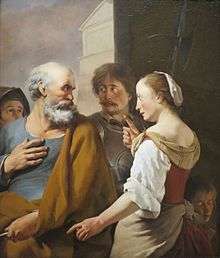
Context
For much of the period of three years that Jesus spent in ministry, gathering and teaching disciples, he had been observed, criticised and harassed by scholars and priests. His teachings were sometimes seen as heretical and his actions in gathering a group of disciples as possibly having political motivation. Jesus' capture and trials were the culmination of this antipathy.
Peter was one of the twelve disciples most closely associated with Jesus. His denials are made in the face of accusation that he was "with Jesus", the term indicating the bond of discipleship. The Gospel of Matthew states that Peter denied Jesus "in front of everyone", thus making a public witness, affirming this with an oath (Matthew 26:72). Throughout his Gospel, Matthew stresses the importance of public witness as an essential element of discipleship, stating in Matthew 10:32-33: "Whoever acknowledges me before men, I will also acknowledge him before my Father in heaven. But whoever disowns me before men, I will disown him before my Father in heaven." Peter's denial is in direct conflict with the nature of discipleship, as described by Matthew.[13] Matthew has also previously reported Jesus' teaching forbidding the use of an oath:
- “Again you have heard that it was said to those of old, ‘You shall not swear falsely, but shall perform your oaths to the Lord’. But I say to you, do not swear at all: neither by heaven, for it is God’s throne; nor by the earth, for it is His footstool; nor by Jerusalem, for it is the city of the great King. Nor shall you swear by your head, because you cannot make one hair white or black. But let your ‘Yes’ be ‘Yes,’ and your ‘No,’ ‘No.’ For whatever is more than these is from the evil one. (Matthew 5:33-37)
The New Testament descriptions of Peter's denial depict the drama of the incident. Peter's antagonists in the discussion of his discipleship progress from a maid, to a maid plus a bystander, to a whole crowd. His denial progresses from a plea of ignorance, to a denial plus an oath and then to cursing and swearing with a total denial that he ever knew Jesus. The significance of three denials lies in its superlative force; it underscores the disciple’s resolve to deny Jesus (see Biblical numerology). The sound of the rooster then brings a shock to Peter that Jesus had predicted the three denials.[14]
This episode has been seen as an incident that sheds light on the unique role of Peter and sets him apart from the other disciples, just as in the Gospel of Mark 16:7 in which the angel tells the women to "go and tell his disciples and Peter" about the resurrection of Jesus.[15] In this episode, as often elsewhere in the Gospel of Mark, Peter acts as the focus of the apostles, and an essential Christological image is presented: the denials of Peter contrast with the frank confessions of Jesus in his trial by the Sanhedrin, portraying his faithfulness as prophet, Son and Messiah.[16]
The triple denial of Peter is the impetus for the three repetitive questions made by Jesus to Peter at the Sea of Galilee after His resurrection, "Simon, son of John, Do you love me?" Both events are tied together by a setting/prop that is found only twice in the New Testament: a charcoal fire burning in the background (Greek: ἀνθρακιά, anthrakia in John 18:18 and 21:9).[17] Although originally interpreted by Peter as a rebuke for his three denials (also due to the use by Jesus of his old name "Simon"), this event became later viewed as a redemptive act by Jesus, allowing Peter to publicly declare in front of his fellow disciples that he truly did love his Lord and thus become fully restored to his faith community. (John 21:15-17).
The triple denial is also echoed in Peter's triple refusal to eat the animals when he has a vision of a sheet with animals in Acts 10.[18]
The three 'denials' are also present in a Gnostic source, the Apocalypse of Peter from the Nag Hammadi library, but the roles are reversed in the context of meditation and seeing inner vision of the Master. In the Gnostic Apocalypse of Peter, Jesus denies Peter "three times in this night" as not ready for inner sight, 72,5. Both details of "three times" denied and "in this night" being present suggests a relationship to the canonical portrayal of the Denial of Peter.[19]
Prayers and traditions
Bishop Lancelot Andrewes composed the following prayer:
O Lord Jesus Christ, look upon us with those eyes of thine where-with thou dist look upon Peter in the hall; that with Peter we may repent and, by the same love be forgiven; for thine endless mercy's sake. Amen.[20]
Referring to the tears shed by Peter during his repentance in the context of the Sacrament of Penance, Saint Ambrose said that "in the Church, there are water and tears: the water of Baptism and the tears of repentance".[21] Traditionally, "tears of repentance", as exemplified by Peter, have become a symbol both of mourning and comfort and a sign at once of sins repented and forgiveness sought.[22]
In the Scriptural Way of the Cross, introduced in 1991 by Pope John Paul II as a version of the Stations of the Cross and performed each Good Friday at the Colosseum in Rome, the fourth station is the Denial of Peter.[23]
During Holy Week in Jerusalem, vigils at times stop at a location traditionally considered the location for the Repentance of Peter, not far from the house of the High Priest of Israel Caiaphas, involved in the Sanhedrin trial of Jesus.[24]
In art and music
The episode has been the subject of works of art for centuries. It has also been dramatized in musical settings of the Passion story. It has been depicted in a varieties of mediums and methods, ranging from 6th century mosaic at the Basilica of Sant'Apollinare Nuovo to Russian icons and oil paintings by many old masters. The subject was sometimes included in cycles of the Life of Christ or the Passion, often as the only scene not to include the figure of Christ.
In Rembrandt's 1660 depiction of The Denial of Saint Peter, now in the Rijksmuseum, Amsterdam, influenced by engravings of the c.1623 version by Gerard Seghers, he presents the servant girl who recognizes Peter with a candle, illuminating Peter's face. Two soldiers look with suspicion as Peter speaks, while Jesus is shown in the distance, his hands bound behind him, turning to look at Peter. Peter's faces away from Jesus, and he gestures with his left hand, although his expression is free of defiance.[25]
Caravaggio's 1610 Denial of Saint Peter is now at the Metropolitan Museum of Art in New York. Author George Weatherhead admires Caravaggio's depiction, the way Peter exhibits a wavering trepidation in his unsteady features, conscious of the unworthy falsehood he was telling. His lips quiver and his eyes seek, yet can not find the firmness of truth.[26] In this painting, Caravaggio portrayed the servant girl using the same head of the woman that he used in his depiction of The Beheading of Saint John the Baptist.[27]
A related subject, the Repentance of Peter, showing the end of the episode, was not often seen before Catholic Counter-Reformation art, where it became popular as an assertion of the sacrament of Confession against Protestant attacks. This followed an influential book by the Jesuit Cardinal Robert Bellarmine (1542–1621). The image typically shows Peter in tears, as a half-length portrait with no other figures, often with hands clasped as at right, and sometimes the cock in the background; it was often coupled with a repentant Mary Magdalen, another exemplar from Bellarmine's book.[28]
The Passion story has been set in music by numerous composers. The episode of Peter's denial is conveyed with great poignancy by J.S. Bach in both the St Matthew Passion and the St John Passion. John Eliot Gardiner (2013, p. 365) says "Inevitably we suffer with Peter; but the uncomfortable question Bach asks us to consider is, would any of us have emerged from his ordeal with greater credit?.[29]
- Denial of Saint Peter in art
 Basilica of Sant'Apollinare Nuovo, 6th century
Basilica of Sant'Apollinare Nuovo, 6th century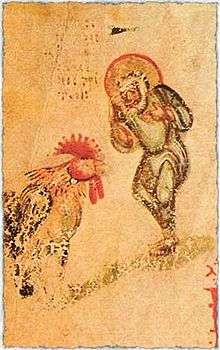 Chludov Psalter, 9th century
Chludov Psalter, 9th century- Duccio, 1308-1311
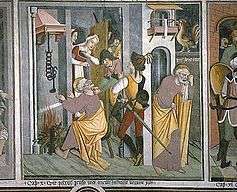 Our Lady of the Fountains (La Brigue), 15th century
Our Lady of the Fountains (La Brigue), 15th century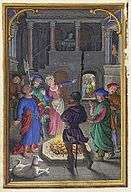 Simon Bening, 1525-1530
Simon Bening, 1525-1530 Jan van der Venne : Denial of Saint Peter
Jan van der Venne : Denial of Saint Peter Repentance of Peter, Petr Brandl, 1724
Repentance of Peter, Petr Brandl, 1724 Knüpfer, Denial of Saint Peter
Knüpfer, Denial of Saint Peter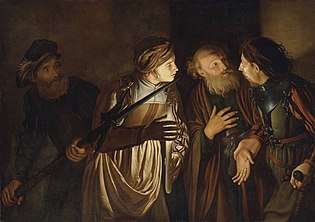 Adam de Coster, The Denial of Saint Peter
Adam de Coster, The Denial of Saint Peter Theodoor Rombouts, The Denial of Saint Peter, 1789
Theodoor Rombouts, The Denial of Saint Peter, 1789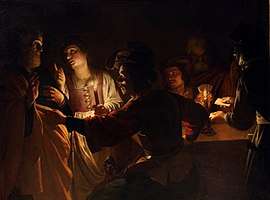 Gerard van Honthorst, The Denial of Saint Peter, c.1618-1620
Gerard van Honthorst, The Denial of Saint Peter, c.1618-1620.jpg) Nicolas Tournier, Denial of St Peter, c.1625
Nicolas Tournier, Denial of St Peter, c.1625 Mathieu Le Nain, The Denial of Saint Peter, 1648
Mathieu Le Nain, The Denial of Saint Peter, 1648
See also
| Part of a series on |
| Saint Peter |
|---|
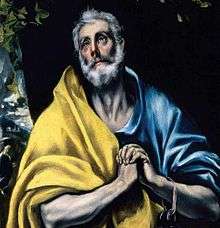 |
| In the New Testament |
| Other |
|
| Part of a series on |
| Penance and Reconciliation in the Catholic Church |
|---|
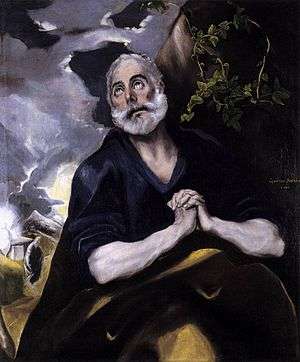 |
|
|
Notes
- "The Denial of St. Peter". North Carolina Museum of Art. Retrieved 15 April 2019.
- Theological Dictionary of the New Testament by Gerhard Kittel, Geoffrey William Bromiley, Gerhard Friedrich 1980 ISBN 0-8028-2248-7 page 105
- Peter: apostle for the whole church by Pheme Perkins 2000 ISBN 0-567-08743-3 page 85
- In the Gospel of John, Peter does not react to the rooster's crowing; unlike the Synoptics, he is not said to recall Jesus' prediction nor to express regret about his denials.
- The Gospel according to Matthew, Volume 1 by Johann Peter Lange 1865 Published by Charles Scribner Co, NY page 499
- "Bible gateway Matthew 26:33-35 NIV". Biblegateway.com. Retrieved 2018-04-19.
- "Biblegateway Luke 22:55-57 NIV". Biblegateway.com. Retrieved 2018-04-19.
- "Biblegateway Mark 14:69-70 NIV". Biblegateway.com. Retrieved 2018-04-19.
- "Biblegateway Matthew 26:73-75 NIV". Biblegateway.com. Retrieved 2018-04-19.
- "Biblegateway Luke 22:59-62 NIV". Biblegateway.com. Retrieved 2018-04-19.
- "Biblegateway John 18:13-27 NIV". Biblegateway.com. Retrieved 2018-04-19.
- Repentance in Christian theology by Mark J. Boda, Gordon T. Smith 2006 ISBN 0-8146-5175-5 page 110
- The Passion and Resurrection narratives of Jesus: a commentary by Stephen J. Binz 1989 ISBN 0-8146-1771-9 page 54
- The Collegeville Bible Commentary: New Testament by Robert J. Karris 1992 ISBN 0-8146-2211-9 page 900
- Peter: apostle for the whole church by Pheme Perkins 2000 ISBN 0-567-08743-3 page 65
- Prophet, Son, Messiah: narrative form and function in Mark 14-16 by Edwin Keith Broadhead 1994 ISBN 1-85075-476-4 page 154
- James L. Resseguie, “A Narrative-Critical Approach to the Fourth Gospel” in Characters and Characterization in the Gospel of John, ed. Christopher W. Skinner (London: Bloomsbury T & T Clark, 2013), 3-17 at p. 9.
- Ben Witherington, The Acts of the Apostles: A Socio-Rhetorical Commentary (Grand Rapids: Eerdmans, 2008), 350.
- "The Apocalypse of Peter - The Nag Hammadi Library". Gnosis.org. Retrieved 2018-04-19.
- Prayers for People Under Pressure by Jonathan Aitken 2006 ISBN 0-8264-8275-9 page 58
- "Vatican website, Catechism item 1429". Vatican.va. Retrieved 2018-04-19.
- Repentance in Christian theology by Mark J. Boda, Gordon T. Smith 2006 ISBN 0-8146-5175-5 page 223
- "Vatican website Fourth Station: Jesus is denied by Peter". Vatican.va. Retrieved 2018-04-19.
- The week of salvation: history and traditions of Holy Week by James Monti ISBN 0-87973-532-5 page 150
- The Biblical Rembrandt by John I. Durham 2004 ISBN 0-86554-886-2
- A pedestrian tour through France and Italy by George Hume Weatherhead 2009 ISBN 1-150-13941-2 page 232
- Caravaggio: the art of realism by John L. Varriano 2006 ISBN 0-271-02717-7 page 110
- Hall, pp. 10 and 315
- Gardiner, J. E. (2013) Music in the Castle of Heaven: a Portrait of Joann Sebastian Bach. London, Allen Lane.
References
| Wikimedia Commons has media related to Peter's denial. |
- James Hall, A History of Ideas and Images in Italian Art, 1983, John Murray, London, ISBN 0-7195-3971-4
.jpg)
